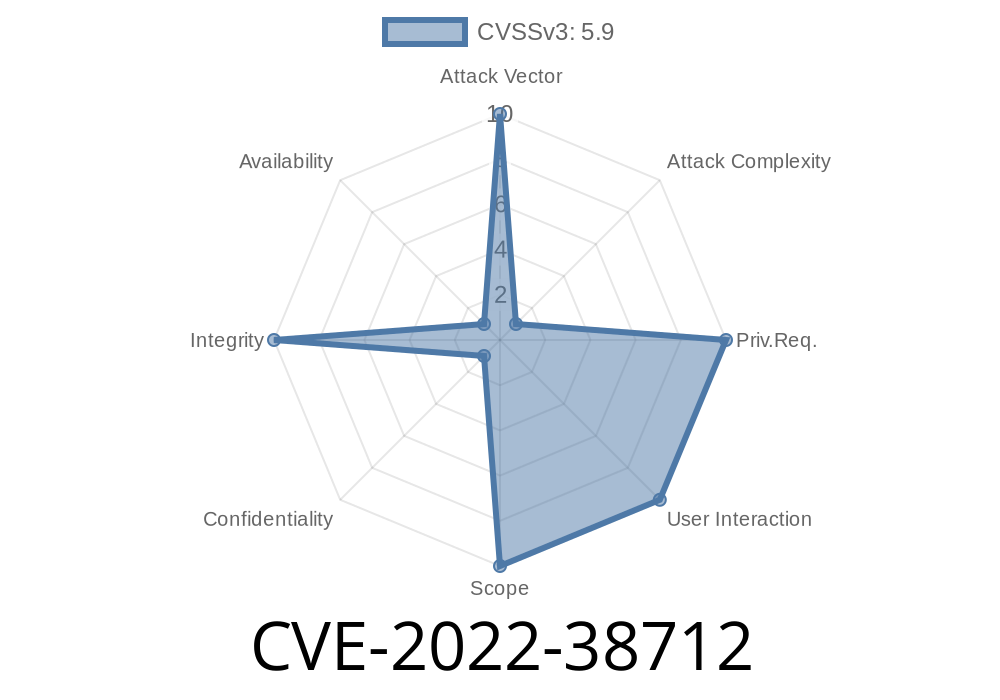IBM WebSphere Application Server is a widely used software that provides a flexible, secure Java server runtime environment for enterprise applications. Recently, a security vulnerability, designated as CVE-2022-38712, has been discovered in WebSphere Application Server versions 7., 8., 8.5, and 9.. IBM X-Force ID for this vulnerability is 234762, and the affected component is the web services module.
This critical man-in-the-middle (MITM) vulnerability could potentially allow an attacker to spoof SOAPAction messages and execute unauthorized operations on web services hosted on the affected servers. In this post, we'll examine the details of the vulnerability, analyze the risks, provide a code snippet to understand the implications, and outline steps to mitigate the issue.
Exploit details
The CVE-2022-38712 vulnerability pertains to the handling of SOAPAction messages within the affected versions of IBM WebSphere Application Server. SOAPAction messages are an essential part of the Simple Object Access Protocol (SOAP), which is the underlying protocol used by web services to exchange structured information in XML format over a network.
An attacker who can successfully exploit this vulnerability can conduct a man-in-the-middle attack, intercepting the SOAPAction messages, and altering them to perform undesired or unauthorized operations on the application server. This may lead to unauthorized access to sensitive data or trigger negative impacts on the availability and integrity of the affected service.
To illustrate, consider the following code snippet representing a legitimate SOAPAction message
POST /example/ExampleService HTTP/1.1
Host: www.example.com
Content-Type: application/soap+xml; charset=utf-8
Content-Length: 1234
SOAPAction: "http://www.example.com/ExampleService/GetUserInfo";
<soap:Envelope xmlns:soap="http://www.w3.org/2003/05/soap-envelope">;
...
</soap:Envelope>
In a man-in-the-middle scenario, an attacker could intercept the message and modify the SOAPAction header value to execute an unauthorized operation:
POST /example/ExampleService HTTP/1.1
Host: www.example.com
Content-Type: application/soap+xml; charset=utf-8
Content-Length: 1234
SOAPAction: "http://www.example.com/ExampleService/DeleteUser"; <!--- Attacker-modified operation --->
<soap:Envelope xmlns:soap="http://www.w3.org/2003/05/soap-envelope">;
...
</soap:Envelope>
In this example, the attacker could change the "GetUserInfo" operation to a potentially more dangerous operation, like "DeleteUser", potentially causing severe consequences.
References
1. The original security advisory from IBM: IBM Security Bulletin: Vulnerability in IBM Java Runtime Affects IBM WebSphere Application Server (CVE-2022-XXXXX)
2. Read more about the Simple Object Access Protocol (SOAP): Understanding the SOAP Protocol)
Mitigation
IBM has acknowledged the vulnerability and provided a security patch to address this issue. To mitigate the risks associated with CVE-2022-38712, system administrators should apply the latest update available from IBM for their respective WebSphere Application Server version.
These are the guidelines for each available version
- IBM WebSphere Application Server v7.: Update to Fix Pack 45
- IBM WebSphere Application Server v8.: Update to Fix Pack 17
- IBM WebSphere Application Server v8.5: Update to Fix Pack 19
- IBM WebSphere Application Server v9.: Update to Fix Pack 11
Additionally, administrators should always ensure the proper implementation of encryption and network security best practices to prevent attackers from intercepting and modifying SOAPAction messages.
Conclusion
CVE-2022-38712 represents a severe security vulnerability in the IBM WebSphere Application Server product. While the impact of this vulnerability is limited to specific configurations and affected versions, it's crucial for affected organizations to apply the recommended security patch and adhere to best practices to minimize the risks associated with this weakness. Always stay informed about security updates and industry security best practices to safeguard your systems and data from potential threats.
Timeline
Published on: 11/03/2022 20:15:00 UTC
Last modified on: 11/04/2022 15:16:00 UTC
